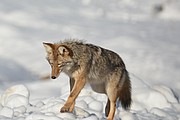Why are we hearing more coyotes howl?
“Whenever the pressure of our complex life thins my blood and numbs my brain, I seek relief in the trail; and when I hear the coyote wailing to the yellow dawn, my cares fall from me — I am happy.”
— Hamlin Garland, American author (1860-1940)
I stepped outside on my deck last week to look at the moon and breathe the crisp night air. The evening was clear, cold and seemingly silent. I took another deep breath, not wanting to linger in the chill. And then a howl rippled through the air. Coyote. The sound echoed through the neighborhood, carrying clearly from the nearby Kootenai River Valley.
I stopped and enjoyed the vocalizations. The long howls were interspersed with sharp yips, sounding like multiple animals. It lasted for several minutes and then I went inside. Since I was a boy and heard it for the first time, I never tire of that sound, no matter how many times I hear it. And this time of year, I enjoy the coyote concert often.
Coyotes are one of the most vocal mammals. They’re also found widely in Boundary County and the Northwest. In fact, there’s a good chance that you have some roaming near you.
You can hear them at any time of year, but you may notice increased activity in February and March. And, if you’re like me, you’ll find the howling particularly resonant on a cold winter’s night.
The reason for the howling this time of year, quite simply, it’s breeding season. While the exact timing varies, depending on geography, coyote breeding season generally occurs between late January and March. Coyotes are generally monogamous, forming strong pair bonds for several years. Some researchers state that the coyotes will remain together until one of the pair dies.
Coyotes are also territorial — the pair howls and yips to let other coyotes know that they have an established territory and not to intrude.
Generally, the group yip-howls are produced by a mated and territorial pair of “alpha” coyotes, with the male howling while the female intersperses her yips, barks, and short howls. The “beta” coyotes (the children of the alpha pair from previous years) and current-year pups may join in if they are nearby, or respond with howls of their own.
At times other nearby pairs may then respond, announcing their own territories. At such times, it can sound like a cascade of howls across the landscape. A pack of coyotes howling is an iconic sound of the American West.
The group yip howl is thought to have the dual purpose of promoting bonding within the family group while also serving as a territorial display. In other words, the coyotes are saying “we’re a happy family, and we own this turf so you better keep out.” In a sense, the group howls create an auditory fence around a territory, supplementing the physical sent marks left by the group.
If you do happen to find yourself in some wide-open spaces this month, step outside in the night and have a listen. You may enjoy one of the great sound shows in nature, the chorus of yips and howls. The coyote survives and thrives despite us, and its howling serves as a reminder to the wildness still around us.
Enjoy Boundary County and all of its sights and sounds!



